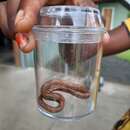en
names in breadcrumbs


Candoia carinata, known commonly as the Pacific ground boa, Pacific keel-scaled boa, or Indonesian tree boa, is a species of snake in the family Boidae.[2]
C. carinata is found in Indonesia, New Guinea, and the Bismarck Archipelago.[1]
C. carinata is popular as a pet in Indonesia, where it is known by the common name monopohon (pohon means "tree" in the Indonesian language).
While the nominate subspecies, C. c. carinata, may be occasionally found in trees, this Papuan snake is most often found on the ground.[3]
Males of C. c. paulsoni are smaller and lighter than females,[3] and show spurs. Males are 0.9–1.0 m (35–39 in) long, and 300–400 g (11–14 oz) in weight. Females are generally 1.2–1.4 m (47–55 in) in length and weigh 1.0–1.2 kg (2.2–2.6 lb). The colour varies from dark brown to auburn with distinct patterns, though there is also the color morph "paulsoni santa isabella ", which is white.
The subspecies C. c. paulsoni was elevated to species status as Candoia paulsoni by H.M. Smith, et al. in 2001.[1]
Commonly known as Tepedelen's bevel-nosed boa.[1]
The specific name or subspecific name, paulsoni, is in honour of Swedish herpetologist John Paulson.[4]
The subspecific name, tepedeleni, is in honour of herpetologist Kumaran Tepedelen.[4]
Candoia carinata, known commonly as the Pacific ground boa, Pacific keel-scaled boa, or Indonesian tree boa, is a species of snake in the family Boidae.